<< Back Homemade Soymilk II: Fun With Okara
Having slogged my way through those first two funky batches of soymilk, it was time to try again, this time using the proper measurements. It turns out that one SoyQuick cup = 1/2 actual cup. Of course! Does anyone else see this as a disaster waiting to happen? That being said, the first batch wasn't a total disaster--many recipes actually call for "2 cups" of soybeans (i.e. 1 actual cup, which is what I used). For this most recent batch, I followed Julie Hasson's recipe pretty closely, but used Zoa's filtration method, to compare against the previous batch. Though still a tad beany, it was much smoother and tastier than the first round. I would actually dunk a cookie in this batch, did in fact enjoy it on a bowl of cereal. Observe:
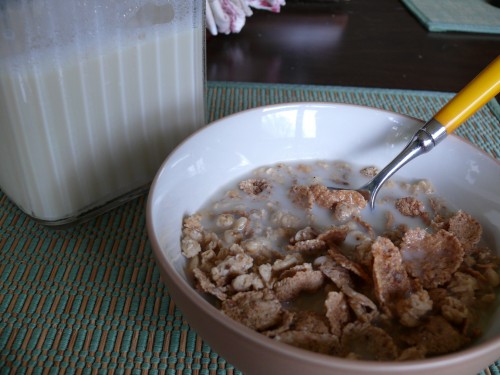
To get a sense of the taste, and where I might want to go with it, I didn't add anything to the soymilk initially. Though not as beany as the first batches, it was still just outside the drinkable-on-its-own range. As per Julie's recipe, I added in 4 tbsp malt extract powder (make sure it's extract powder, not just powder; and don't use syrup; you can find it at shops that sell home-brewing supplies). This gives the soymilk a richer taste, and sweetens it just a hair--not enough for it to be "sweet", but enough to cut any bitter edge and cut down on the beany flavor. If I were going to use this as my unsweetened batch, I would have stopped there. But I wanted a drinkable version that I could put on my cereal, so I added 1 tbsp of sugar. It's still not sweet, per se, but was awesome on my cereal.
Aside from using too many beans and not filtering enough the first time, I think I also made a few mistakes with sweeteners. I used agave in one and brown rice syrup in the other--and then re-filtered the soymilk after adding the syrups. This caused the second jug of the first batch to separate horribly. I should have been much more scientific in my approach, but I can't recall which jug had which sweetener. Using the powers of inductive reasoning, I've concluded that it was the brown rice syrup batch that separated, as that was supposed to be the "unsweetened" batch, and it was the unsweetened batch that separated. So. Agave would appear to be safe. Additionally, I don't know if it was the brown rice syrup, the second filtration, or the combination of the two that was truly at fault. I think as a general rule of thumb, stick with powders over syrups. Syrups separate. The best bet for sweetening is probably to follow Zoa's lead and just add raw dates to the soymilk maker up front.
With a new batch of soymilk on the way, I also had a new batch of okara on the way--meaning I needed to use up my previous store. I didn't do anything to dry my okara out, beyond mashing it with a spoon into the filters during the filtration process. So, my okara is "wet". Before I explore the intricacies of wringing out the okara a little, I thought I'd explore the limits of laziness and establish some uses for a wetter okara.
As I mentioned in the previous post, I made Zoa's Okara Seitan Chik'n. Aside from the salad and bowties, I made a veggie & chik'n couscous--using not only the okara seitan, but also cooking the couscous in the broth from the seitan. Everything in its place.
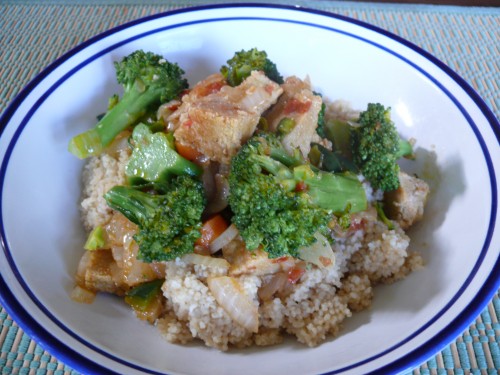
The next night, Joe treated me to his famous Spicy Ramen (recipe forthcoming!), a true delicacy. Made, not surprisingly, with seitan chik'n.
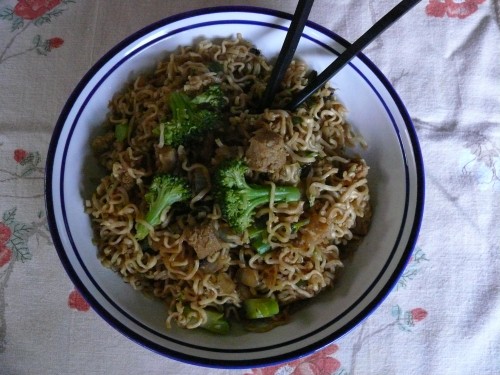
As you may have noticed, asparagus is no longer in season, and broccoli now is. Farewell asparagus! Welcome broccoli!
Even after making the okara seitan, I still had 2 full cups (actual cups, not SoyQuick cups!) of okara leftover. What to do with it? Then it hit me--broccoli & rice bake-em-up! I replaced the tofu with the 2 cups of wet okara and the 2 cups of faux milk with 1.5 cups of water. Also, since the farmer's market was the next morning and I'd run out of broccoli, I used kale from our garden, subbing 2 cups of chopped kale for the broccoli. It turned out perfectly!
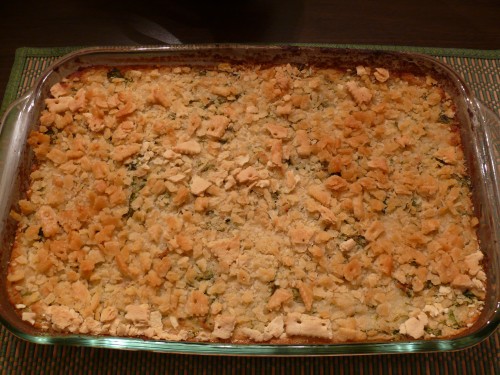
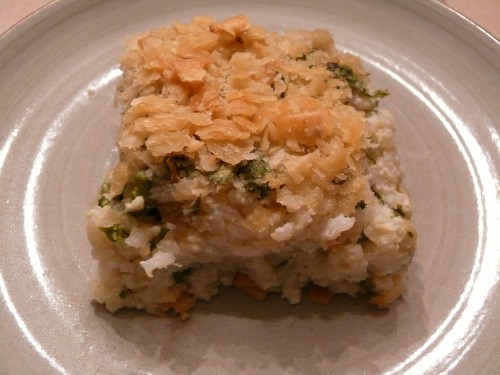
As is true of the standard version of this recipe, you will end up with too much sauce. Save out 1 - 1.5 cups, and you should be left with just the right amount. You can use the leftover sauce for Okara Chik'n Al-faux-do--for a double dose of okara action!
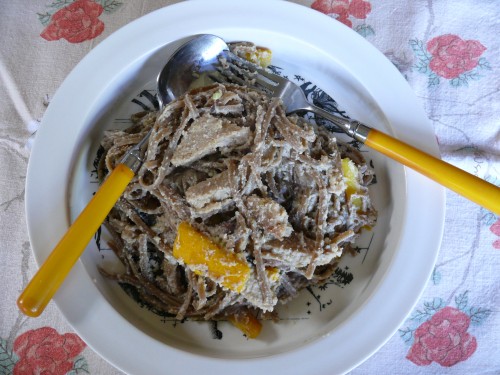
And what better time? Summer squash is popping up everywhere at the farmer's market. But maybe this is too much? I've gone off the okara/soymilk deep end?
Perhaps, perhaps. Of course, this is just the sort of challenge I appreciate--and just the sort of challenge you've come to know and love during my occasional bachelorhoods: how can we use everything up without wasting anything? In general, we should train ourselves to see reducing waste and getting the most out of the resources that we use as a fun challenge, rather than an oppressive burden. In centuries past, this is how people had to cook--something that we've moved away from with advent of better preservation and, ultimately, processed, packaged, single-serving meals.
Consider it: making one batch of soymilk has shaped, in many ways, two weeks of cooking. Not quite the same as buying a carton of soymilk. And what happens to all of the waste produced during the commercial soymilk-making process?
[A]s a significant byproduct of soy milk and tofu manufacturing, okara is commonly used as animal feed since its production usually exceeds demands for human consumption. For this reason, it is not uncommon for tofu and soymilk factories to be located close to animal farms in many Asian countries. In Western countries, okara is used almost exclusively for the production of pig and cattle feed, although it does appear as an ingredient for vegetarian burger patties. - Wikipedia entry on Okara (food)
So, chances are that if you're consuming commercial soymilk, you're contributing (very) indirectly to factory farming. I say this uncritically, as we're all enmeshed in the tangled system and can only extricate ourselves one bit at a time. The focus here is not on why you want to avoid commercial soymilks, but why you might want to make your own--as a way to be closer to your food and its production; to reduce physical waste; to eat more locally; and to understand your diet holistically, to see your food choices not in the context of a single meal, but rather as a week of meals, a month, a season.
Okay. I'm getting off my soapbox now and heating up some leftovers!

